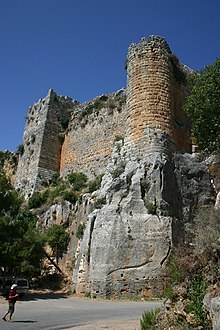Qalʿat Salah ed-Din
| Qal'at Salah ed-Din | ||
|---|---|---|
|
South bastion with donjon |
||
| Alternative name (s): | Qalaat Sahyun; Château de Saone; Saladinsburg | |
| Creation time : | 10th century | |
| Castle type : | Hilltop castle | |
| Conservation status: | ruin | |
| Geographical location | 35 ° 35 '45 " N , 36 ° 3' 27" E | |
|
|
||
Qal'at Salah ed-Din ( Arabic قلعة صلاح الدين, DMG Qalʿat Ṣalāḥ ad-Dīn ; also Qalʿat Ṣahyūn , Château de Saône or Saladinsburg ) is a castle in Syria . Since 2006, the Saladin of the joint UNESCO - World Heritage Site " Krak des Chevaliers . And Citadel of Salah Ed-Din"
location
The Saladinsburg lies on the western slope of the Jebel Aansariye , a mountain range that gradually rises from the Mediterranean coast, about 30 kilometers east of Latakia . The road crosses al-Haffe 5 kilometers before; the next larger town in the east is Slinfah . The castle hill is surrounded by a protected area with high pine forest.
history
Byzantines and Arabs
The first castle complex already existed in the 10th century. There is documentary evidence that the castle was conquered by the Byzantine emperor John I Tzimiskes , who wrested it from the Hamdanids of Aleppo in 975. The castle was strategically located as it dominated the road from the port city of Latakia to the Orontes Valley and Aleppo. Under the Byzantines , the castle was expanded into an important fortress. It had small round towers that protruded from the wall of the curtain wall. On the endangered east side there were four parallel walls from one side of the castle hill to the other. In the middle of the castle hill there was a rectangular core castle with square protrusions made of small-sized stones.
Crusaders
In 1108 the castle fell to the Crusaders under Tankred of Antioch , who had expanded his territory in fierce fighting. Tankred gave it as a fief in 1119 to Robert von Sahyun , one of his high-ranking followers. The castle became the center of an important domain. During the fighting for the city of Zerdana , which he owned , Robert was captured and executed in the same year. Atabeg Tugtakin is said to have had his skullcap set as a drinking bowl in gold ( skull cup ). Robert's fiefdom took over his son Wilhelm , who thus became the most important vassal of the Principality of Antioch.
The income from his dominion enabled Wilhelm to expand the castle in a generous way. While it is typical for other crusader castles of the time that they were built quickly and cheaply, we encounter a very carefully constructed castle in the Franconian complex. A large number of very knowledgeable workers were employed and carefully trimmed boss stones were used. The donjon on the east side of the castle consists partly of exceptionally large, well-hewn and up to four meters long boss stones. But the most impressive part of the castle is the large moat. It was carved into the rock over a length of 130 m, a width of 20 m and a depth of 28 m. Only one crag, which carried a bridge pillar to the east gate, was left standing. A new wall with square towers was built on the endangered south side. The influence of Byzantine fortress architecture can be demonstrated here. Towers and battlements on the walls are not connected to each other, so that they can be defended individually.
In addition to the gate on the large moat, the castle had three other gates. The eastern gate is protected by two flanking semicircular towers, a drawbridge and the moat. The construction of the other gates, staggered kennel gates, is borrowed from Byzantine fortress architecture.
Ayyubids and Mamluks
After the victory at Hattin in 1187, the Ayyubid Sultan Saladin undertook a large-scale campaign in 1188 to Lebanon and Syria. In order to be able to take Antioch , he first besieged Sahyun. On July 24, 1188, he stood in front of the castle with his army and six throwing machines. Two throwing machines were placed on the northeast corner and the other four on the south side of the castle. On July 25th, stone bullets were fired. Failures by the besieged were unsuccessful. The walls began to give way on July 26th. Saladin's soldiers penetrated the castle through breaches. The Franks withdrew to the upper part of the castle. In their hopeless situation they agreed to surrender. After paying a ransom, the count's family was able to leave the castle. Count Wilhelm von Sahyun himself (a descendant of the above Wilhelm) was brought to Damascus and executed. The reason the huge castle fell so quickly was the lack of a sufficient crew.
Saladin gave the castle to the family of the Emir Nasir ad-Din Mankawar . Under Emir Mankawar, the damage caused by the siege was repaired. The repairs can still be seen today on the northeast corner. Other buildings from the Ayyubid period are the remains of a bath.
In 1272 the Mamluk Sultan Baibars took possession of the complex. In 1280, at a time of heavy fighting against the Mongols , the Mamluk emir Sunqur al-Achqar acquired the castle and established an independent rule here. In 1287 Sultan Qalawun recaptured the castle for the Egyptian Mamluk Empire. The remains of the mosque that have been preserved date from the time of Qalawun.
Web links
Individual evidence
- ↑ cf. Reinhold Röhricht : History of the Kingdom of Jerusalem (1100–1291) . Wagner, Innsbruck 1898. p. 478




